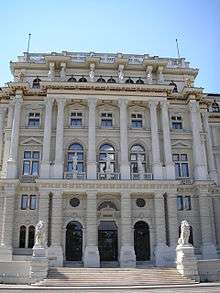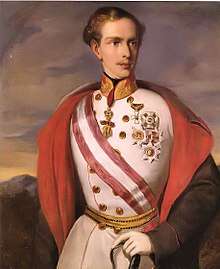Supreme Court of Justice (Austria)
The Supreme Court of Justice (German: Oberster Gerichtshof or OGH) in Austria is the final court of appeal for criminal and civil lawsuits other than administrative. The court also deals with service-related complaints by jurists against the judiciary and with disciplinary complaints against jurists; it acts as the trial court in cases involving certain senior judges and prosecutors, as an appeals court in cases involving lower-level judges and prosecutors, attorneys, and notaries. In addition to its adjudicative responsibilities, the court is charged with running the Republic's official public law library (the Zentralbibliothek) and with publishing appraisals of draft legislation presented to the National Council by the government.
| Supreme Court of Justice | |
|---|---|
| Oberster Gerichtshof | |
 Palace of Justice, Vienna | |
| Established | 1848 |
| Location | Vienna |
| Number of positions | 61 |
| Website | ogh.gv.at/ |
| President | |
| Currently | Elisabeth Lovrek |
| Since | July 1, 2018 |
In spite of its name, the court is not a supreme court in the strict sense of the term: it has no powers of judicial review, does not adjudicate on liability claims against the Republic and its bureaucracy, does not handle impeachments of elected officials, and does not resolve demarcation conflicts.
The court does not have a fixed number of members. As of the early 21st century, there are typically between fifty and sixty justices on the court; as of August 2018, the exact number of sitting judges is 61. The responsibility for appointing Supreme Court justices is vested in the President of Austria, but the President can and usually does delegate this task to the minister of justice. The minister picks from a shortlist of three nominees provided by the court itself.
The Supreme Court of Justice convenes in the Palace of Justice in Vienna.
Background
The Austrian judiciary is divided into general courts (German: ordentliche Gerichte) and courts of public law (Gerichte öffentlichen Rechts). The courts of public law supervise the other two branches of government. One of its limbs, the administrative court system, reviews the legality of administrative acts.[1] Its other limb, the Constitutional Court, adjudicates on liability claims against the Republic, its provinces, and its municipalities,[2] demarcation conflicts between courts or between courts and bureaucrats,[3] complaints regarding the constitutionality of statutes or the legality of ordinances,[4] election complaints,[5] and complaints regarding the conduct of elected officials and political appointees in office.[6] The general courts handle all remaining civil cases and all criminal trials as well as non-adversary proceedings such as inheritance cases or legal guardianship matters.
The hierarchy of general courts has four levels: district, regional, higher regional, and supreme. For most cases, original jurisdiction lies with one of the 115 district courts (Bezirksgerichte); the verdict of a district court can be appealed to the relevant regional court (Landesgericht). Some cases are first tried before one of the 18 regional courts and can be appealed to the relevant higher regional court (Oberlandesgericht). The four higher regional courts and the Supreme Court of Justice do not have original jurisdiction; they exclusively hear appeals.[7]
The constitutional right to an appeal is taken seriously in Austria. Any party to any trial before a general court can file an appeal on facts and law (Berufung).[8] If the case is a civil case, the appellate court first checks whether the trial court has committed procedural errors; if yes, it orders a retrial, sending the case back to the trial court.[9] If no, or if the case is criminal, the appellate court conducts what is essentially a retrial itself − the appellate trial does not merely review questions of law but also questions of fact, assessing evidence and questioning witnesses.[10]
In addition to the appeal on facts and law against the verdict of the trial court, an appeal at law (Revision in civil trials, Nichtigkeitsbeschwerde in criminal cases) can be filed against the verdict of the appellate court.[11] In criminal cases, appeals at law that are not obviously frivolous are also handled in public hearings.[12] A successful appeal at law not just overturns but complete erases the verdict of the appellate court, sending the case down the ladder again. Verdicts of trial courts − although not of appellate courts − that result from the trial court's application of an unconstitutional statute or an illegal ordinance can additionally be fought with extraordinary appeals at law to the Constitutional Court.
Powers and responsibilities

The Supreme Court of Justice hears appeals at law (Revisionen and Nichtigkeitsbeschwerden) against verdicts of lower appellate courts.[13]
In addition to its role in public trials, the court also deals with some of the Austrian judiciary's internal disputes. It hears, as the court of original jurisdiction, complaints lodged by judges against the bureaucracy and disciplinary complaints against certain senior judges and prosecutors.[14] It has appellate jurisdiction in disciplinary proceedings against lower-ranking judges and prosecutors, attorneys, and notaries. Decisions handed down by the court are final; there is no appeal against the Supreme Court of Justice in internal affairs proceedings any more than there is in ordinary trials.[15]
In addition to its adjudicative functions, the court is charged with publishing appraisals of draft legislation presented to the National Council by the government; the court is required to evaluate a government bill if asked to do so by the president of the court of by the minister of justice.[16] The court does not have the authority to actually veto legislation, however, and neither does it have the soft power to make draft bills politically untenable. Austria is a parliamentary democracy in which most bills originate not with individual legislators but with the cabinet; the country has also had strong consociationalist tendencies historically and remains highly consensus-oriented to this day.[17] Formal expert opinions on draft bills offered by political lobbying groups, professional associations, churches, regional governments, and various arms of the national bureaucracy are a routine part of the legislative process; neither the cabinet nor the legislature are required to defer to any of them.[18]
The court maintains the Zentralbibliothek, the Republic's official public law library.[19]
Composition
The Supreme Court of Justice consists of a president, a vice president, and as many additional members as court and cabinet deem necessary and appropriate.[20] As of the early 21st century, the court typically has fifty and sixty members.[21] As of August 2018, the exact number of sitting justices is 61.[22]
As with any other court in the Austrian general courts system, Supreme Court justices are professional judges; they have graduated from law school, done several months of internship-type practical work in an actual courthouse,[23] received four years of post-graduate training,[24] and passed a special exam.[25]
Supreme Court justices cannot be members of a national or provincial cabinet or legislative body.[26]
The responsibility for appointing justices is vested in the President of Austria, but the president can and usually does delegate this task to the minister of justice.[27] The court maintains a special personnel committee (Personalsenat) that provides the minister with a shortlist of three candidates in the event of a vacancy.[28] In theory, the minister may appoint any Austrian legally qualified to sit the bench and not excluded by the constitution's rudimentary incompatibility provisions. In practice, the minister dependably picks one of the three candidates nominated by the court.[29]
Process
For the purpose of actually trying cases, the court is partitioned into 18 panels (Senate) of five members each.[30]
As everywhere in the Austrian court system, panels are subject to a fixed and specific apportionment of responsibilities (feste Geschäftseinteilung).[31] The fixed apportionment is meant to prevent the government from influencing outcomes by hand-picking a panel sympathetic to its perspective.[32] One panel exclusively deals with appeals decisions reached by arbitration tribunals; another panel hears to appeals to antitrust verdicts handed down by the Vienna higher regional court, which has specialist exclusive jurisdiction over all Austrian antitrust cases. A third panel handles disciplinary proceedings and other disputes internal to the judiciary. Of the remaining fifteen panels, ten deal with civil cases and five with criminal trials.[33]
A new case that comes before the court is first assigned to the relevant panel. One of the members of the panel is appointed case manager (Berichterstatter). The case manager directs the preliminary research. An office staffed with about 30 to 40 researchers and other assistants is attached to the court to aid case managers in this task.[34] Once the preliminary investigation is complete, the panel convenes, hears the official presentation of case and research by the case manager, deliberates, and votes. The case manager votes first, the chair votes last; other members vote in order of decreasing seniority.[35]
In cases that are trivial or routine, the panel is permitted to meet as a panel of just three (Dreiersenat).[36] If a panel of five (einfacher Senat) suspects that a case currently before it may raise a question of law of wider importance (Rechtsfrage von grundsätzlicher Bedeutung) and that existing Supreme Court case law in the matter is ambiguous or inconsistent, the panel has to add an additional six members, for a total of eleven. A case that raises a question of law of wider importance also requires a panel of eleven (verstärkter Senat) if the verdict is going to overturn a large body of existing Supreme Court case law (ein Abgehen von der ständigen Rechtsprechung) or a verdict handed down by another panel of eleven.[37]
The court only rarely meets in plenum; a plenary session is mainly required to authorize the yearly activity report.[38]
History

The earliest recognizable precursor of the modern Supreme Court of Justice was the Supreme Judicial Office (German: Oberste Justizstelle) established under Maria Theresa in 1749. In its current form, the court goes back to the Pillersdorf Constitution of 1848. The court survived the persistent political unrest and periodic constitutional upheavals of the 1850s and 1860s, the Austro-Hungarian Compromise of 1867, and the collapse of the Empire at the end of World War I. Except for a change of name, it was retained unaltered both by the provisional government of the emerging First Austrian Republic in 1918 and by the Constitution of 1920. The court was dissolved following the Nazi takeover of Austria in 1938 but resurrected after Austria's liberation from Nazi rule in 1945.
Absolutist era
Between shortly after 1300 and shortly before 1800, the Habsburgs had gradually transformed their empire from a personal union of numerous independent realms and territories into a highly centralized unitary state.[39] Feudal structures had been replaced with rules-based bureaucracies, hereditary local potentates with professional civil servants. The consolidation and modernization of jurisprudence, on the other hand, had been allowed to lag. Civil and criminal procedure as well as the criminal code proper had made great strides forward during the reigns of Maria Theresa and Joseph II in the late 18th century, a period of rapid and profound reform.[40] In the early 19th century, Francis II had revolutionized the civil code. In terms of its organizational structure, however, the court system was still essentially medieval.
Original jurisdiction over most civil and criminal matters resided with local princes (Landesfürsten) in some regions, with the estates of the realm (Landstände) in others, with petty landlords in parts of the countryside, and with proto-democratic municipal governments in certain cities. Clergy, aristocracy, transients, or members of guilds could be subject to claims of jurisdiction based not on locale or subject matter but purely on social class.[41] There was no systematic separation of powers between judiciary and administration.[42] The State as such mostly only exercised a limited amount of appellate jurisdiction. The Supreme Judicial Office (Oberste Justizstelle) in Vienna, created by Maria Theresa in 1749, functioned both as a token court of last appeal and as a rudimentary ministry of justice.[43]
Constitutional era

The Revolutions of 1848, whose goals included constitutional rule, equality before the law, and the abolition of outdated remnants of the feudal system, finally forced the Habsburgs to take drastic action. The first milestone was the Pillersdorf Constitution enacted by Emperor Ferdinand in April 1848. The constitution promised increased civil liberties, provided for a limited form of democratic participation in government, and stipulated that from now on all jurisprudence would be within the purview of the sovereign, implicitly promising and end to Austria's jumbled mess of landlord, estate, and ecclesiastical courts.[44] Another milestone was an edict issued on August 21 abolishing the Supreme Judicial Office and creating the Supreme Court of Cassation (Oberster Gerichts- und Kassationshof).[45]
When Ferdinand's concessions failed to appease the revolutionaries and Ferdinand was forced to abdicate, his successor, Emperor Franz Joseph, promulgated the March Constitution, elaborating on a number of the provisions of the Pillersdorf Constitution. In particular, the March Constitution confirmed that the judicial powers and responsibilities of landlords, cities, and ecclesiastical corporations were abolished. All disputes were to be settled by the State, in courts explicitly created by statutory law and according to procedure explicitly set forth in statutory law.[46] The new constitution also expressly established judicial independence[47] and the separation of powers of judiciary and executive.[48]
Subsequent legislation pursuant to the March Constitution created a system of general courts that also survives, with a few significant but narrow alterations, to this day.[49] Most notably, the Constitution of the Courts (Gerichtsverfassungsgesetz or GVG) of June 1849 and the Penal Procedure Code (Strafprozessordnung or StPO) of January 1850 implemented an empire-wide hierarchy of trial and appellate courts that is virtually identical to the system in existence now.[50]
A statute enacted in August 1850 established the panel system and otherwise detailed Supreme Court organization and procedure.[51]
Effective 1852, Franz Joseph rescinded the March Constitution, attempting to reestablish himself as an absolute monarch.[52] A complete rewrite of the Penal Procedure Code in 1853 eliminated judicial independence and, partially, the separation of powers.[53] The hierarchy of trial and appellate courts in general and the Supreme Court of Cassation at its top in particular, however, survived. The court then also survived the gradual return to constitutional rule between 1860 and 1868, although it lost jurisdiction over the eastern half of the Empire when the Lands of the Crown of Saint Stephen gained legal independence in the Austro-Hungarian Compromise of 1867.[54]
Republic
The collapse of the Empire at the end of World War I and the Austrian rump state's subsequent transition from monarchy to democratic republic necessitated a number of changes to Austria's system of courts of public law. The system of general courts, on the other hand, remained largely unaffected, except of course for its drastic decrease in geographic reach. A pair of laws enacted by the emerging republic's provisional government in late 1918 and early 1919 confirmed the Supreme Court in its existence. The only thing the transition really changed was the name: the Supreme Court of Cassation (Oberster Gerichts- und Kassationshof) became the Supreme Court of Justice (Oberster Gerichtshof).[55]
The Kelsen Constitution of 1920 retained the Supreme Court of Justice unaltered.[56]
The Austrofascist Federal State of 1934 also kept the court in place.[57]
Suspension under the Nazis
The absorption of Austria into the German Reich in March 1938 made the Supreme Court superfluous and, in fact, inconvenient. For one thing, the German judiciary used the same four-tier hierarchy as its Austrian counterpart. The judicial districts served by German and Austrian local, regional, and higher regional courts, respectively, were roughly comparable in size. Decisions of Germany's 28 higher regional courts were appealed to the Reichsgericht in Leipzig; there was no strong reason for an extra appeals court intermediating between the Reichsgericht and the paltry 3 higher regional courts of the Reich's new province, the State of Austria (Land Österreich). For another thing, the Nazis were already planning to dissolve the State of Austria into a number of unconnected provinces (Reichsgaue) in the near future; any institution that expressly and specifically served the territory traditionally known as Austria would eventually have to be disbanded in any case.[58]
The court ceased operations in March 1939.[59]
When Austria regained independence in 1945, the Supreme Court was swiftly brought back, in its former role and with its former structure.[60][61]
Citations
- ZPO, §477, §494, §496.
- ZPO, §482, §484.
- StPO, §§285c-285d, §286.
- RStDG, §82, §90.
- Pelinka 1998, pp. 50–56.
- RStDG, §2.
- RStDG, §9.
- RStDG, §16.
- B-VG, Art. 92 (2).
- B-VG, Art. 86 (1).
- Graf 2006, p. 76.
- OGHG, §5 (2).
- OGHG, §9.
- Brauneder 2009, p. 79.
- Brauneder 2009, pp. 29, 37–40, 44, 66, 93–94.
- Brauneder 2009, p. 66.
- RGBl. 150/1848, §20, §100.
- RGBl. 150/1848, §101.
- Brauneder 2009, pp. 127−128.
References
Books and Articles
English
- Foster, Nigel (2013). Austrian Legal System and Laws. Routledge. ISBN 978-1-135-33658-5.CS1 maint: ref=harv (link)
- Lijphart, Arend (1999). Patterns of Democracy: Government Forms and Performance in Thirty-Six Countries. New Haven and London: Yale University Press. ISBN 978-0-300-07893-0.CS1 maint: ref=harv (link)
- Pelinka, Peter (1998). Out of the Shadow of the Past. Boulder, Colorado: Westview Press. ISBN 978-0-8133-2918-5.CS1 maint: ref=harv (link)
- Schaarschmidt, Thomas (2017). "Multi-Level Governance in Hitler's Germany: Reassessing the Political Structure of the National Socialist State". Historical Social Research. 42 (2): 282−242. JSTOR 44234960.CS1 maint: ref=harv (link)
- Stelzer, Manfred (2011). The Constitution of the Republic of Austria: A Contextual Analysis. Boomsbury. ISBN 978-1-847-31649-3.CS1 maint: ref=harv (link)
German
- Adamovich, Ludwig (1947). Grundriss des österreichischen Verfassungsrechts (4th ed.). Vienna: Springer. ISBN 978-3-709-13505-1.CS1 maint: ref=harv (link)
- Adamovich, Ludwig; Funk, Bernd-Christian; Holzinger, Gerhart; Frank, Stefan (2011). Österreichisches Staatsrecht. Band 1: Grundlagen (2nd ed.). Vienna: Springer. ISBN 978-3-211-89396-8.
- "Aufgaben". Oberster Gerichtshof. Retrieved 2018-08-29.
- Berka, Walter (2016). Verfassungsrecht (6th ed.). Vienna: Österreich Verlag. ISBN 978-3-7046-7281-0.CS1 maint: ref=harv (link)
- Botz, Gerhard (1976). Die Eingliederung Österreichs in das Deutsche Reich. Planung und Verwirklichung des politisch-administrativen Anschlusses (1938−1940). Europaverlag. ISBN 978-3-203-50627-2.CS1 maint: ref=harv (link)
- Brauneder, Wilhelm (2009). Österreichische Verfassungsgeschichte (11th ed.). Vienna: Manzsche Verlags- und Universitätsbuchhandlung. ISBN 978-3-214-14876-8.CS1 maint: ref=harv (link)
- "Drittes Reich". Oberster Gerichtshof. Retrieved 2018-08-30.
- "Einrichtung". Oberster Gerichtshof. Retrieved 2018-08-30.
- "Erste Republik". Oberster Gerichtshof. Retrieved 2018-03-30.
- "Geschäftsverteilung". Oberster Gerichtshof. Retrieved 2018-08-30.
- Graf, Philipp J (2006). "Österreichs höchste Richter" (PDF). Öffentliche Sicherheit. No. 3–4/2006. Austrian Ministry of the Interior. pp. 75–81.
- Hoke, Rudolf (1996). Österreichische und deutsche Rechtsgeschichte (2nd ed.). Vienna: Böhlau Studienbücher. ISBN 978-3-205-98179-4.CS1 maint: ref=harv (link)
- Öhlinger, Theo (2007). Verfassungsrecht (7th ed.). Vienna: Facultas. ISBN 978-3-7089-0152-7.CS1 maint: ref=harv (link)
- "Österreichisch-Ungerische Monarchie". Oberster Gerichtshof. Retrieved 2018-08-30.
- Pernthaler, Peter (1989). Kompetenzverteilung in der Krise. Vienna: Wilhelm Braumüller. ISBN 978-3-7003-0811-9.CS1 maint: ref=harv (link)
- "Richterinnen und Richter". Oberster Gerichtshof. Retrieved 2018-08-29.
- "Zentralbibliothek". Oberster Gerichtshof. Retrieved 2018-08-29.
- "Zweite Republik". Oberster Gerichtshof. Retrieved 2018-08-30.
Statutes
Historical
- RGBl 1848/150, Reichsverfassung für das Kaiserthum Oesterreich. Retrieved October 2, 2018.
- RGBl 1848/278, Grundzüge der neuen Gerichtsverfassung. Retrieved October 2, 2018.
- RGBl 1850/25, Provisorische Strafproceß-Ordnung. Retrieved October 2, 2018.
- RGBl 1850/325, Organisation des obersten Gerichts- und Cassationshofes in Wien. Retrieved October 2, 2018.
- StGBl 1918/38, Grundgesetz über die richterliche Gewalt. Retrieved October 2, 2018.
- StGBl 1919/41, Gesetz betreffend die Einrichtung eines Obersten Gerichtshofes. Retrieved October 2, 2018.
- BGBl 1920/1, Bundes-Verfassungsgesetz. Retrieved October 2, 2018.
- BGBl 1934-II/1, Verfassung 1934. Retrieved October 2, 2018.
- GBlÖ 1939/307, Verordnung zur weiteren Überleitung des Rechtspflege im Lande Österreich und in den sudetendeutschen Gebieten. Retrieved October 2, 2018.
- StGBl 1949/47, Wiederherstellung der österreichischen Gerichtsorganisation. Retrieved October 2, 2018.
- StGBl 1949/94, Überleitung der Verwaltungs- und Justizeinrichtungen. Retrieved October 2, 2018.
Current
- "Bundesverfassungsgesetz (B-VG) as last amended May 15, 2018 by BGBl. 22/2018". May 15, 2018. Retrieved 2018-08-29.
- "OGH-Gesetz (OGHG), consolidated version as last amended December 28, 2007 by BGBl. 112/2007". Retrieved 2018-08-29.
- "Richter- und Staatsanwaltschaftsdienstgesetz (RStDG), consolidates version as last amended by August 14, 2018 by BGBl. 60/2018". August 14, 2018. Retrieved 2018-08-29.
- "Strafprozeßordnung 1975 (StPO) as last amended May 17, 2017 by BGBl. 32/2018". May 17, 2017. Retrieved 2018-08-29.
- "Zivilprozessordnung (ZPO), consolidated version as last amended May 15, 2018 by BGBl. 32/2018". May 17, 2018. Retrieved 2018-08-29.
